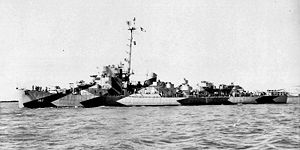- USS Finnegan (DE-307)
-

Career 
Name: USS Finnegan Laid down: 5 July 1943 Launched: 22 January 1944 Commissioned: 19 August 1944 Decommissioned: 27 November 1945 Struck: 19 December 1945 Honors and
awards:3 battle stars (World War II) Fate: Sold for scrapping, June 1946 General characteristics Type: Evarts-class destroyer escort Displacement: 1,140 long tons (1,158 t) standard
1,430 long tons (1,453 t) fullLength: 289 ft 5 in (88.21 m) o/a
283 ft 6 in (86.41 m) w/lBeam: 35 ft 2 in (10.72 m) Draft: 11 ft (3.4 m) (max) Propulsion: 4 × General Motors Model 16-278A diesel engines with electric drive, 6,000 shp (4,474 kW)
2 screwsSpeed: 19 knots (35 km/h; 22 mph) Range: 4,150 nmi (7,690 km) Complement: 15 officers and 183 enlisted Armament: • 3 × single 3"/50 Mk.22 dual purpose guns
• 1 × quad 1.1"/75 Mk.2 AA gun
• 9 × 20 mm Mk.4 AA guns
• 1 × Hedgehog Projector Mk.10 (144 rounds)
• 8 × Mk.6 depth charge projectors
• 2 × Mk.9 depth charge tracksUSS Finnegan (DE-307) was an Evarts-class destroyer escort constructed for the United States Navy during World War II. She was sent off into the Pacific Ocean to protect convoys and other ships from Japanese submarines and fighter aircraft. She performed escort and antisubmarine operations in dangerous battle areas and returned home with three well-earned battle stars.
She was named after Chief Radio Electrician William Michael Finnegan who was killed during the Japanese attack on Pearl Harbor; was launched on 22 February 1944 by Mare Island Navy Yard; sponsored by Mrs. Charles Schroeder, sister of Ensign Finnegan; and commissioned on 19 August 1944, Lieutenant Commander Hoffman, USNR, in command.
Contents
World War II Pacific Theater operations
Finnegan arrived at Pearl Harbor on 8 November 1944 to serve as escort for submarines conducting training exercises prior to their war patrols. She voyaged to Midway Island escorting a transport between 11 and 20 December, then returned to duty with submarines until 9 January 1945. After amphibious training exercises in the Hawaiian Islands, Finnegan sailed escorting a group of LSTs and submarine chasers, two of which she towed for parts of the passage to Saipan.
Supporting the Iwo Jima operations
On 15 February 1945, the escort ship sailed from Saipan for the assault on Iwo Jima, during which she screened transports as they launched their boats for the initial invasion on 19 February.
Sinking of Japanese Submarine I-370
On 26 February, while escorting empty transports to Saipan, Finnegan made a surface contact by radar, and was detached from the screen to locate and sink Japanese submarine I-370 in a four-hour attack, in 22°45′N 141°27′E / 22.75°N 141.45°E.
Supporting invasion of Okinawa operations
From Saipan, Finnegan screened the transports on to Espiritu Santo, arriving 15 March 1945. She sailed ten days later for Ulithi, the vast base from which the Okinawa assault was staged, and on 9 April, she reached the newly assaulted island. Sailing on anti-submarine patrols, as well as screening assault shipping, Finnegan fired to drive off a would-be suicide plane on 28 May. On 10 July she departed Okinawa for duty in the Philippines on local escort and patrol assignments until 15 September.
Post-War decommissioning
Finnegan then sailed for Eniwetok, Pearl Harbor, and Charleston, South Carolina, where she was decommissioned and placed in reserve on 27 November 1945. She was sold for scrapping in June 1946.
Awards
Finnegan received three battle stars for World War II service.
References
- This article includes text from the public domain Dictionary of American Naval Fighting Ships. The entry can be found here.
See also
External links
- Photo gallery of USS Finnegan (DE 307) at NavSource Naval History
 United States NavyCompleted
United States NavyCompletedBayntun · Bazely · Berry · Blackwood · Evarts · Wyffels · Griswold · Steele · Carlson · Bebas · Crouter · Burges · Brennan · Doherty · Austin · Edgar G. Chase · Edward C. Daly · Gilmore · Burden R. Hastings · LeHardy · Harold C. Thomas · Wileman · Charles R. Greer · Whitman · Wintle · Dempsey · Duffy · Emery · Stadtfield · Martin · Sederstrom · Fleming · Tisdale · Eisele · Fair · Manlove · Greiner · Wyman · Lovering · Sanders · Brackett · Reynolds · Mitchell · Donaldson · Andres · Drury · Decker · Dobler · Doneff · Engstrom · Seid · Smartt · Walter S. Brown · William C. Miller · Cabana · Dionne · Canfield · Deede · Elden · Cloues · Lake · Lyman · Crowley · Rall · Halloran · Connolly · Finnegan · O'Toole · John J. Powers · Mason · John M. Bermingham
CancelledCreamer (ex-Register) · Ely · Delbert W. Halsey · Keppler · Lloyd Thomas · William C. Lawe · Willard Keith · Unnamed (DE-315)
 Royal Navy
Royal Navy
Captain class (diesel-electric type)Categories:- Evarts class destroyer escorts
- World War II mine warfare vessels of the United States
- Ships built in Vallejo, California
- 1944 ships
Wikimedia Foundation. 2010.
